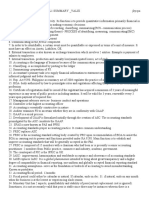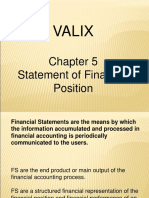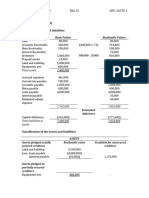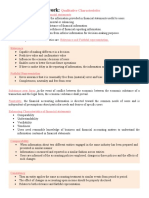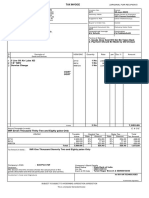PAS 8 Accounting Policies, Estimates and Errors
PAS 8 Accounting Policies, Estimates and Errors
Uploaded by
panda 1Copyright:
Available Formats
PAS 8 Accounting Policies, Estimates and Errors
PAS 8 Accounting Policies, Estimates and Errors
Uploaded by
panda 1Original Description:
Copyright
Available Formats
Share this document
Did you find this document useful?
Is this content inappropriate?
Copyright:
Available Formats
PAS 8 Accounting Policies, Estimates and Errors
PAS 8 Accounting Policies, Estimates and Errors
Uploaded by
panda 1Copyright:
Available Formats
PAS 8 Accounting Policies, Estimate and Errors
Accounting policies are the specific principles, bases, conventions, rules and practices applied by an entity in preparing and
presenting financial statements.
Change in accounting policy
Once selected, accounting policies must be applied consistently for similar transactions and events. A change in accounting policy
shall be made only when:
Required by an accounting standard
The change will result in more relevant and faithful represented information about the financial position, financial
performance and cash flows of the entity.
How to report
A change a change in
in accounting accounting
policy policy
arises when an entity adopts a generally accepted accounting principles which is different from the
A change in accounting
one previously used by the entity. policy required by a standard or an interpretation shall be applied in accordance with the transitional
provisions therein.
a) Change in the method of inventory pricing from the FIFO to weighted average method
b) If Change
the standard
in theormethod
interpretation containsfornolong-term
of accounting transitional provisionscontract
construction or if anfrom
accounting policy ismethod
cost recovery changed voluntarily, ofthe
to percentage
change shall be
completion applied retrospectively or retroactively.
method.
c) The initial adoption of policy to carry assets at revalued amount is a change in accounting policy to be dealt with as
Retrospective application
revaluation.
d) Retrospective
Change fromapplication
cost modelmeans
to fair that
valueany resulting
model adjustment
in measuring from theproperty.
investment change in accounting policy shall be reported as an
e) adjustment
Change totoa the
newopening balance ffrom
policy resulting retained earnings. of a new PFRS.
the requirement
The amount of the adjustment is determined as of the beginning of the year of change
If comparative information is presented, the financial statements of the prior period presented shall be restated to conform
with the new accounting policy.
Absence of accounting standard
In the absence of accounting standard that specifically applies to a transaction or event, management shall use judgment in selecting
and applying an accounting policy that results in information that is relevant to the economic decision making needs of users and
faithfully represented.
Accounting Estimate
A change in accounting estimate is a normal recurring correction or adjustment of an asset or liability which is the natural
result of the use of an estimate.
By very nature, the revision of the estimate does not relate to prior periods and is not a correction of an error.
Sometimes it is difficult to distinguish a change in accounting estimate and a change in accounting policy.
o Doubtful accounts
o Inventory obsolescence
o Useful life, residual value and expected pattern of consumption of benefit of depreciable asset
o Warranty cost
o Fair value of asset and liability
How to report a change in accounting estimate
The effect of a change in accounting estimate shall be recognized currently and prospectively by including it in income or
loss of:
o The period of change if the change affects that period only
o The period of change and future periods if the change affects both
A change in an accounting estimate shall not be accounted for by restating amounts reported in financial statements of prior
periods
Changes in accounting estimates are to be handled currently and prospectively, if necessary.
Prospective recognition of the effect of a change in accounting estimate means that the change in accounting estimate means
that the change is applied to transactions, other events and conditions from the date of change in estimate.
Prior period errors
Prior period errors are omissions and misstatements in the financial statements for one and more periods arising from a failure to use
or misuse of reliable information.
How to treat prior period errors
Prior period errors shall be corrected retrospectively by adjusting the opening balances of retained earnings and affected assets and
liabilities.
Problem 1
During 2019, Orca Company decided to change from the FIFO method of inventory valuation to the weighted average
method.
FIFO Weighted average
January 1 7,100,000 7,700,000
December 31 7,900,000 8,300,000
In the statement of retained earnings for 2019, what amount should be reported as the pretax cumulative effect of this
accounting change?
Problem 2
Goddard Company had used the FIFO method of inventory valuation since it began operations in 2016.
The entity decided to change to the weighted average method for measuring inventory at the beginning of 2019.
The following schedule shows year-end inventory balances:
Year FIFO Weighted average
2016 4,500,000 5,400,000
2017 7,800,000 7,100,000
2018 8,300,000 7,800,000
What pretax amount should be reported in the statement of retained earnings for 2019 as the cumulative effect of the change
in accounting policy?
Problem 3
Blue Company purchased a machine on January 1, 2016 for P6,000,000. At the date of acquisition, the machine has a life of six
years with no residual value. The machine was depreciated on a straight-line basis.
On January 1, 2019, the entity determined that the machine has a useful lie of eight years from the date of acquisition with no
residual value,
What is the depreciation of the machine for 2019?
Problem 4
On January 1, 2016. Flax Company purchased a machine for P5,280,000 and depreciated it by the straight line method using
an estimated useful life of eight years with no residual value.
On January 1, 2019, the entity determined that the machine has a useful life of six years from the date of acquisition and the
residual value was P480,000.
An accounting change was made in 2019 to reflect this additional information.
What is the accumulated depreciation for the machine on December 31, 2019?
Problem 5
On January 1, 2017, Milan Company purchased an equipment for P6,000,000. The equipment has been depreciated using the
straight line with residual value of P6,000,000 and useful life of 20 years.
On January 1, 2019, the entity determined that the remaining useful life is 10 years and the residual value is P800,000.
What is the depreciation for 2019?
Problem 6
Acute Company was incorporated on January 1, 2016. In preparing the financial statements for the year ended December 31,
2018, the entity used the following original cost and useful life for the property, plant and equipment:
Original Cost Useful life
Building 15,000,000 15 years
Machinery 10,500,000 10 years
Furniture 3,500,000 7 years
On January 1, 2019, the entity determined that the remaining useful life is 10 years for the building, 7 years for the machinery
and 5 years for the furniture.
The entity used the straight line method of depreciation with no residual value.
What is the total depreciation for 2019?
Problem 7
On January 1, 2017, Brazilia Company purchased for P4,800,000 a machine with a useful life of ten years and a residual value
of P200,000.
The machine was depreciated by the double declining balance and the carrying amount of the machine was P3,072,000 on
December 31, 2018.
The entity changed to the straight line method on January 1, 2019. The residual value did not change.
What is the depreciation expense on this machine for 2019?
Problem 8
On January 1, 2019, Canyon Company decided to decrease the estimated useful life of an existing patent from 10 years to 8
years.
The patent was purchased on January 1, 2014 for P3,000,000. The estimated residual value is zero.
The entity decided on January 1, 2019 to change the depreciation method from an accelerated method to the straight line
method.
On January 1, 2019, the cost of an equipment is P8,000,000 and the accumulated depreciation is P3,400,000.
The remaining useful life of the equipment on January 1, 2019 is 10 years and the residual value is P200,000.
What is the total charge against income for 2019 as a result of the accounting changes?
Problem 9
Aklan Company reported the following events during 2019:
It was decided to write off P1,800,000 from inventory which was over two years old as it was obsolete.
Sales of P1,600,000 had been omitted from the financial statements for the year ended December 31, 2018.
What total amount should be reported as prior period error in the financial statements for the year ended December 31,
2019?
Problem 10
Samar Company reported the following events during the year ended December 31, 2019:
A counting error relating to the inventory on December 31, 2018 was discovered.
This required a reduction in the carrying amount of inventory at that date of P280,000.
The provision for uncollectible accounts receivable on December 31, 2018 was P300,000.
During 2019, an amount of P500,000 was written off related to the December 31, 2018 accounts receivable.
What adjustment is required to restate retained earnings on January 1,2019?
Theories:
You might also like
- PFRS 15 Revenue From Contracts With Customers100% (3)PFRS 15 Revenue From Contracts With Customers7 pages
- Cash Cash Equivalents: Philippine Accounting Standards 7 Statement of Cash FlowsNo ratings yetCash Cash Equivalents: Philippine Accounting Standards 7 Statement of Cash Flows2 pages
- PAS 10 Events After The Reporting PeriodNo ratings yetPAS 10 Events After The Reporting Period2 pages
- PAS 24: Related Party Disclosures: ObjectiveNo ratings yetPAS 24: Related Party Disclosures: Objective3 pages
- Chapter 11 - Accounting Policies, Changes in Accounting Estimates and ErrorsNo ratings yetChapter 11 - Accounting Policies, Changes in Accounting Estimates and Errors3 pages
- CFAS 06 PAS 8 Accounting Policies Estimates and ErrorsNo ratings yetCFAS 06 PAS 8 Accounting Policies Estimates and Errors4 pages
- PAS 8 Accounting Policies, Changes in Accounting Estimates and ErrorsNo ratings yetPAS 8 Accounting Policies, Changes in Accounting Estimates and Errors5 pages
- Pas 29 Financial Reporting in Hyperinflationary EconomiesNo ratings yetPas 29 Financial Reporting in Hyperinflationary Economies2 pages
- Borrowing Costs That Are Directly Attributable To The Acquisition, Construction orNo ratings yetBorrowing Costs That Are Directly Attributable To The Acquisition, Construction or4 pages
- PAS 10 Events After The Reporting PeriodNo ratings yetPAS 10 Events After The Reporting Period2 pages
- PAS 34 Interim Financial Reporting: ObjectiveNo ratings yetPAS 34 Interim Financial Reporting: Objective3 pages
- PAS 8 Accounting Policies, Changes in Accounting100% (1)PAS 8 Accounting Policies, Changes in Accounting7 pages
- Homework On Presentation of Financial Statements (Ias 1)No ratings yetHomework On Presentation of Financial Statements (Ias 1)4 pages
- Chapter 22 - Financial Reporing in Hyperinflationary EconomiesNo ratings yetChapter 22 - Financial Reporing in Hyperinflationary Economies19 pages
- Pas 1 - Presentation of Financial Statements100% (1)Pas 1 - Presentation of Financial Statements27 pages
- PAS 32 - Financial Instruments PresentationNo ratings yetPAS 32 - Financial Instruments Presentation13 pages
- PAS 27 Consolidated and Separate FS ReviewedNo ratings yetPAS 27 Consolidated and Separate FS Reviewed14 pages
- 4 Pas 7 - Statement of Cash Flows: Objective and Scope100% (1)4 Pas 7 - Statement of Cash Flows: Objective and Scope17 pages
- Current at The End of The Reporting Period. Comparative Figures For Prior Period(s) Shall Also Be RestatedNo ratings yetCurrent at The End of The Reporting Period. Comparative Figures For Prior Period(s) Shall Also Be Restated3 pages
- Pas 26 Accounting and Reporting by Retirement Benefit Plans100% (1)Pas 26 Accounting and Reporting by Retirement Benefit Plans2 pages
- Chapter 2 - Statement of Comprehensive Income100% (1)Chapter 2 - Statement of Comprehensive Income13 pages
- PAS 8 - Changes in Acctg Policies, Estimates and ErrorNo ratings yetPAS 8 - Changes in Acctg Policies, Estimates and Error12 pages
- Pas 10 - Events After The Reporting Period100% (1)Pas 10 - Events After The Reporting Period11 pages
- Valix Financial Accounting Summary Chapter 8: Non Current Assets Held For Sale0% (1)Valix Financial Accounting Summary Chapter 8: Non Current Assets Held For Sale3 pages
- Quiz Printing - Pas 7 - Statement of Cash FlowsNo ratings yetQuiz Printing - Pas 7 - Statement of Cash Flows1 page
- Chapter 11: Accounting Policies, Estimate and Errors Pas 8: The Procedure Is Not To Correct Past DepreciationNo ratings yetChapter 11: Accounting Policies, Estimate and Errors Pas 8: The Procedure Is Not To Correct Past Depreciation2 pages
- PAS 8 Accounting Policies, Estimates and ErrorsNo ratings yetPAS 8 Accounting Policies, Estimates and Errors2 pages
- CF Elements, Recognition and Measurement, Capital MaintenanceNo ratings yetCF Elements, Recognition and Measurement, Capital Maintenance11 pages
- CF Elements, Recognition and Measurement, Capital MaintenanceNo ratings yetCF Elements, Recognition and Measurement, Capital Maintenance6 pages
- Philippine Literature During The American Colonial PeriodNo ratings yetPhilippine Literature During The American Colonial Period4 pages
- Pfrs 8: Operating Segments Scope PFRS 8 Applies To The Separate or Individual Financial Statements of An Entity (And To The ConsolidatedNo ratings yetPfrs 8: Operating Segments Scope PFRS 8 Applies To The Separate or Individual Financial Statements of An Entity (And To The Consolidated4 pages
- Misstatement in The Financial StatementsNo ratings yetMisstatement in The Financial Statements3 pages
- Financial Accounting Management Accounting Primary Users Purpose of InformationNo ratings yetFinancial Accounting Management Accounting Primary Users Purpose of Information3 pages
- Introduction To Financial Statement Audit and Management AssertionsNo ratings yetIntroduction To Financial Statement Audit and Management Assertions4 pages
- B S Technologies - Sky-177-22-23 (30-6-22)No ratings yetB S Technologies - Sky-177-22-23 (30-6-22)3 pages
- Manual Input Next To Yellow Cells DCF Intrinsic Value CalculatorNo ratings yetManual Input Next To Yellow Cells DCF Intrinsic Value Calculator5 pages
- Instant download Managing a Global Workforce Challenges and Opportunities in International Human Resource Management 3rd Edition Vance pdf all chapter100% (2)Instant download Managing a Global Workforce Challenges and Opportunities in International Human Resource Management 3rd Edition Vance pdf all chapter81 pages
- The Economic Impact of Googles Data Centre in Belgium 2No ratings yetThe Economic Impact of Googles Data Centre in Belgium 237 pages
- Non-Negotiable: Mol Triumph 0207E Hamburg Jebel Ali Umm QasrNo ratings yetNon-Negotiable: Mol Triumph 0207E Hamburg Jebel Ali Umm Qasr1 page
- Inventory Management KPIs and Metrics For 2022 - NetSuiteNo ratings yetInventory Management KPIs and Metrics For 2022 - NetSuite14 pages
- Quick Commerce Impact On Kirana Report-CompressedNo ratings yetQuick Commerce Impact On Kirana Report-Compressed80 pages
- Humidifier Market - Segmentation Detailed Study With Forecast - Facts and TrendsNo ratings yetHumidifier Market - Segmentation Detailed Study With Forecast - Facts and Trends2 pages
- The Determinants of Customer Satisfaction When Purchasing In-Store Cosmetics in VietnamNo ratings yetThe Determinants of Customer Satisfaction When Purchasing In-Store Cosmetics in Vietnam14 pages
- Corporate Valuation - Mini Assignment 1 (Solution)No ratings yetCorporate Valuation - Mini Assignment 1 (Solution)5 pages
- A Project Report: For The Partial Fulfillment of The Award ofNo ratings yetA Project Report: For The Partial Fulfillment of The Award of51 pages
- Un Análisis Del Comportamiento de La Inflación y El Desempleo en Colombia Los Últimos 20 AñosNo ratings yetUn Análisis Del Comportamiento de La Inflación y El Desempleo en Colombia Los Últimos 20 Años19 pages
- Sustainability Reporting Guide 2022 - FINALNo ratings yetSustainability Reporting Guide 2022 - FINAL156 pages











































